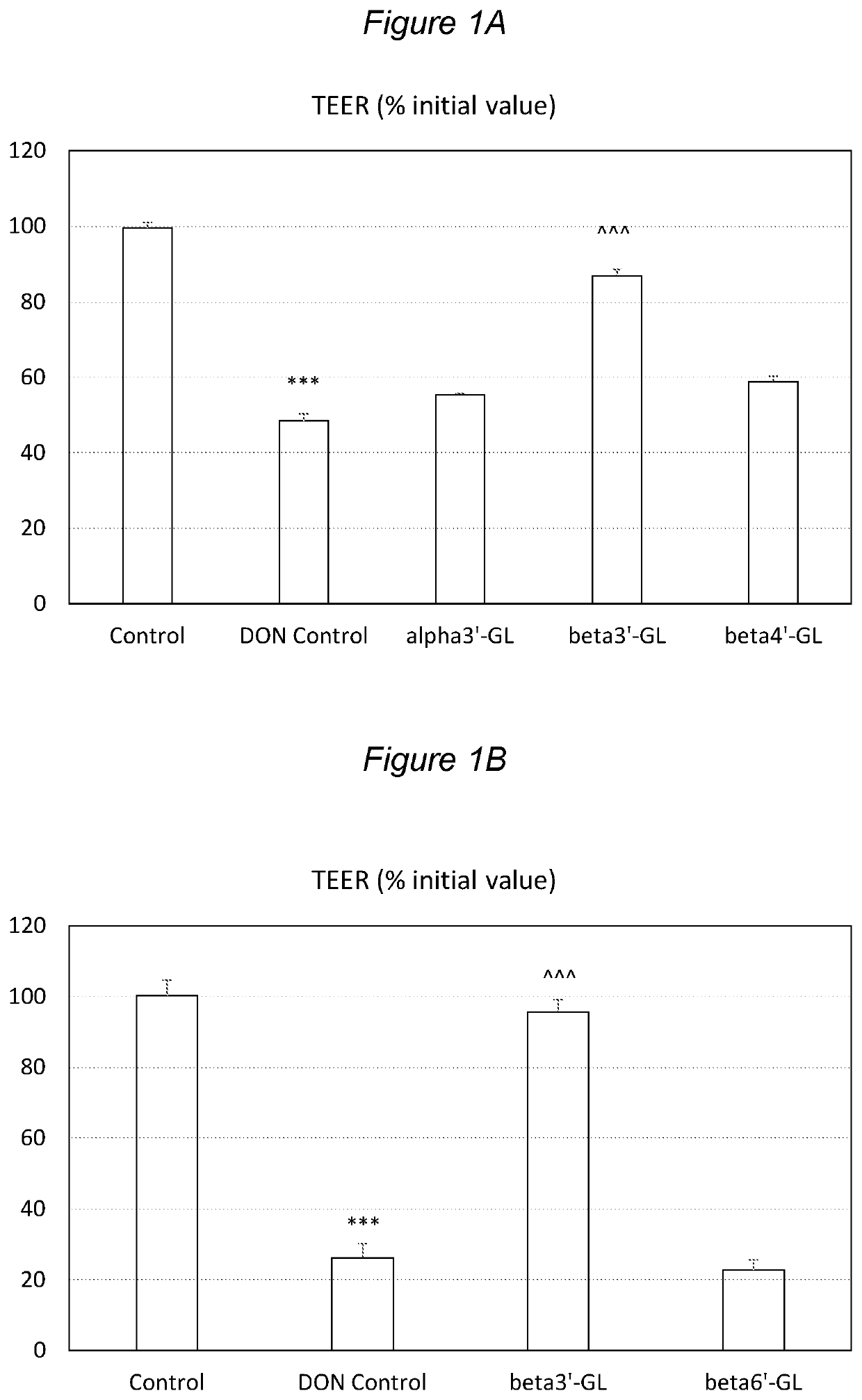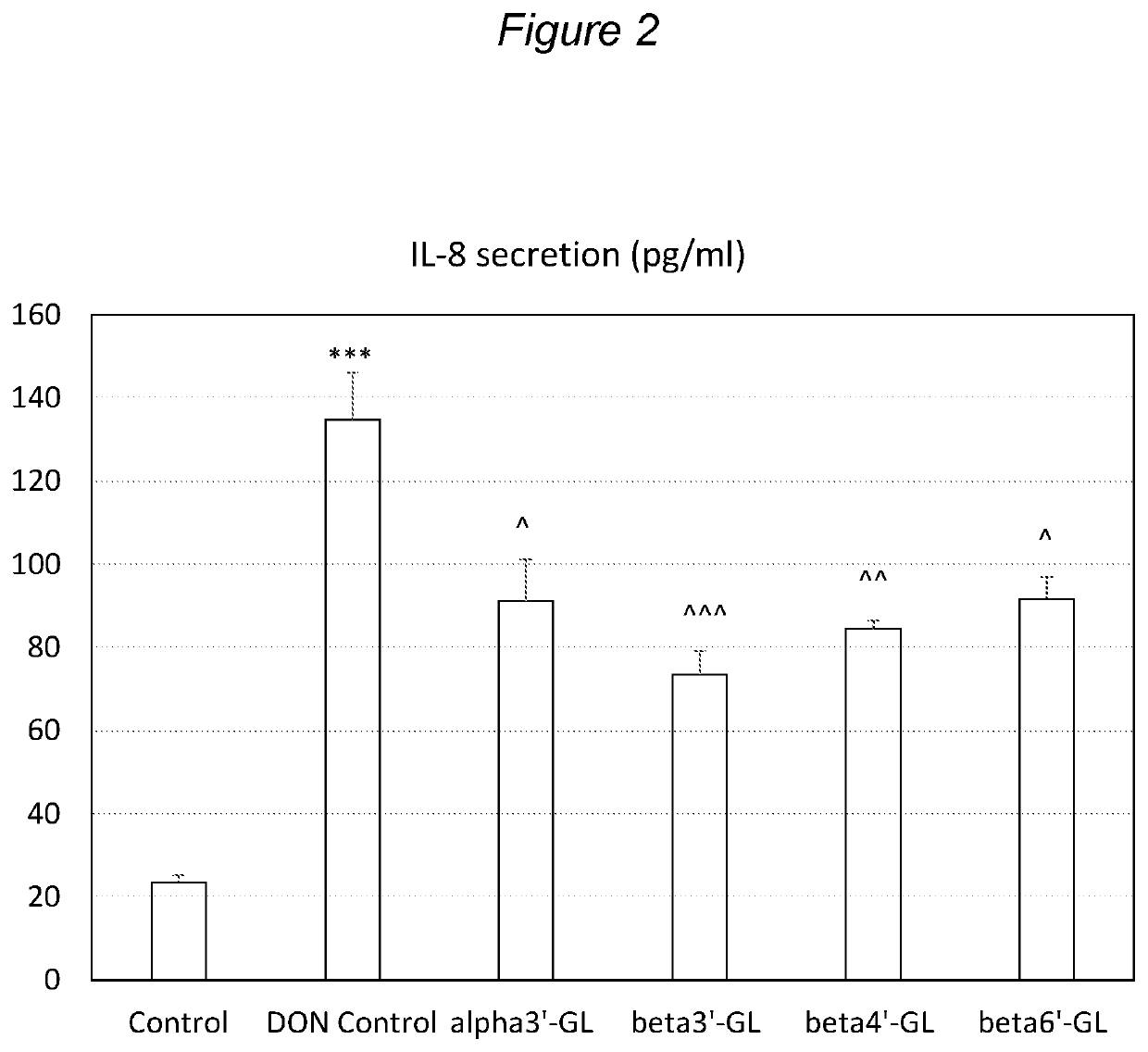Beta-1,3'-galactosyllactose for the treatment of gut barrier function diseases
a technology of galactosyllactose and beta-1,3'-galactose, which is applied in the field of beta-1,3'-galactosyllactose for the treatment of gut barrier function diseases, can solve the problems of not always being able or desirable to breast feed an infant, and achieve the effect of improving the gut barrier function
- Summary
- Abstract
- Description
- Claims
- Application Information
AI Technical Summary
Benefits of technology
Problems solved by technology
Method used
Image
Examples
example 2
Galactosyllactose Specifically Protects against Intestinal Barrier Disruption and Prevents Permeability Increase
[0152]beta1,3′-galactosyl-lactose (beta3′-GL), beta1,4′-galactosyllactose (beta4′-GL) and beta1,6′-galactosyl-lactose (beta6′-GL) were obtained from Carbosynth (Berkshire, UK). alpha1,3′-galactosyl-lactose (alpha3′-GL) was obtained from Elicityl (Crolles, France). Purified deoxydivalenol (DON) (D0156; Sigma Aldrich, St Luis, Mo., USA) was dissolved in pure ethanol and stored at −20° C. Human epithelial colorectal adenocarcinoma (Caco-2) cells were obtained from American Type Tissue Collection (Code HTB-37) (Manasse, Va., USA, passage 90-102).
[0153]Caco-2 cells were used according to established methods. In brief: cells were cultured in Dulbecco's modified Eagle medium (DMEM) and seeded at a density of 0.3×105 cells into 0.3 cm2 high pore density (0.4 μm) inserts with a polyethylene terephthalate membrane (BD Biosciences, Franklin Lakes, N.J., USA) placed in a 24-well plate...
example 3
ixtures of Galacto-Oligosaccharides Beta3′-GL Specifically Protects against Intestinal Barrier Disruption and Prevents Permeability Increase
[0159]Several GOS preparations, comprising varying amounts of beta3′-GL, were tested in this experiment. As a source of beta4′-GL and beta6′-GL VivinalGOS (VGOS) was used. VivinalGOS is available from FrieslandCampina Domo (Amersfoort, The Netherlands) and contains about 59% GOS on dry matter. The DP3 of this GOS is predominantly 4′GL and 6′G.
[0160]Another GOS preparation, herein referred to as TOS, was produced in house by incubating a lactose mixture with Streptococcus thermophilus strain ST065 (this strain is also referred to as strain S. thermophilus CNCM I-1620), as described in more detail in WO 96 / 06924, FR2723960 and EP0778885, and in LeForestier et. al., 2009 Eur J Nutr, 48:457-464, with the additional step that S. thermophilus cell debris material was removed by centrifugation. The obtained TOS was used as a source of beta4′-GL, beta6′...
example 4
ith Short Chain Fatty Acid Fermentation Products Improve Gut Barrier Function
[0170]The effect of a long chain polyunsaturated fatty acids (LC-PUFA) and a mixture of short chain fatty acids (SCFA mix) having a concentration profile that is typical for fermentation of a mixture of galacto-oligosaccharides (TOS) derived from VivinalGOS and long chain fructo-oligosaccharides (RaftilineHP) in a ratio of 9 / 1 (w / w) on barrier permeability was investigated, as disclosed in Example 3 of EP2100520 (incorporated by reference herein) The SCFA mix had a fatty acid profile as shown in FIG. 3A of EP2100520 (incorporated by reference herein) (see second bar in FIG. 3A), i.e. about 75% being acetic acid.
Methods
[0171]T84 human intestinal epithelial cells are commonly used to study intestinal barrier integrity in vitro. T84 cells (ATCC, USA) were cultured on 12 mm transwell inserts (0.4 μm, Corning Costrar, USA) in DMEM-F12 glutamax with penicillin-streptomycin (100 IU / ml), supplemented with 5% FBS-HI...
PUM
 Login to view more
Login to view more Abstract
Description
Claims
Application Information
 Login to view more
Login to view more - R&D Engineer
- R&D Manager
- IP Professional
- Industry Leading Data Capabilities
- Powerful AI technology
- Patent DNA Extraction
Browse by: Latest US Patents, China's latest patents, Technical Efficacy Thesaurus, Application Domain, Technology Topic.
© 2024 PatSnap. All rights reserved.Legal|Privacy policy|Modern Slavery Act Transparency Statement|Sitemap



